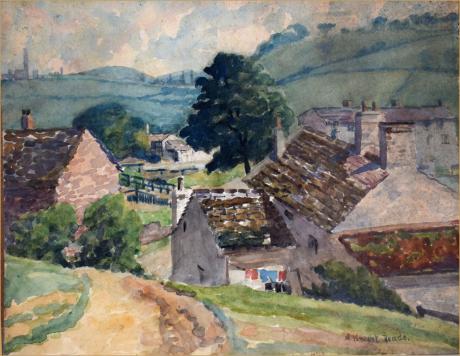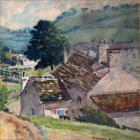New Mills is a small town in Derbyshire, England, approximately 8 miles (13 km) south-east of Stockport and 15 miles (24 km) from Manchester. It lies at the confluence of the rivers Goyt and Sett, close to the border of Cheshire. The town stands above the Torrs, a 70 feet (21 m) deep gorge, cut through Woodhead Hill Sandstone of the Carboniferous period. It is on the north-western edge of the Peak District, England's first national park.
New Mills has a population of approximately 12,000, in a civil parish which includes the villages and hamlets of Whitle, Thornsett, Hague Bar, Rowarth, Brookbottom, Gowhole, and most of Birch Vale. New Mills was first noted for coal mining, and then for cotton spinning and then bleaching and calico printing. New Mills was served by the Peak Forest Canal, three railway lines and the A6 trunk road. Redundant mills were bought up in the mid-twentieth century by a children's sweet manufacturer, Swizzels Matlow, famous for Love Hearts and Drumsticks. New Mills was a stronghold of Methodism.
New Mills is in the area formerly known as Bowden Middlecale which was a grouping of ten hamlets. The name of New Mylne (New Mills) was given to it from a corn-mill, erected in 1391, near to the present Salem Mill on the River Sett in the hamlet of Ollersett.[3] This was adjacent to a convenient bridge over the Sett. By the late sixteenth century the name was applied to the group of houses that grew up round it. Coal mining was the first industry of the area, with up to 40 small pits and mines exploiting the Yard Seam. The climate, good construction stone and the availability of stable land by fast-flowing water was ideal for cotton spinning. Cotton mills and print-works were built in the Torrs Gorge from 1788. Dwellings were built on the sides of the gorge, sometimes with one home built on top of another, both being entered at their respective street levels. Examples still exist on Station Road and Meal Street.
By 1810, New Mills had nine cotton mills, plus three weaving mills and at least three printworks.
Pigot's Directory 1835 describes New Mills:
NEW MILLS, an extensive hamlet, in the parish of Glossop, and in the High Peak hundred, is 14 miles from Manchester, 6 from Chapel-en-le-Frith, and 8 from Stockport. It is pleasantly situate on the borders of Derbyshire and Cheshire; and, within a comparatively few years, has risen to importance in the manufacturing district; cotton spinning being carried on here to a considerable extent, affording employment to numerous hands.
The factories are in a great measure hidden from public view in passing through the village, being built at the foot of the stream, under high towering rocks. Good house coal, as well as other kinds for the purposes of machinery, is obtained near to the village, the top bed strata running from sixteen to twenty inches thick. The village is built chiefly upon a stone quarry, but the soil in many parts is fertile, producing good crops of wheat and potatoes.
A second group of 'later' mills formed by the newly opened Peak Forest Canal in Newtown, a hamlet 800 m away on the other side of the Goyt in what was then the parish of Disley in Cheshire. Increasingly these mills and houses merged into New Mills. The soft iron-free water was suitable for bleaching and finishing and printing. With the advent of steam, and the growth of the canal network to transport raw cotton, coal and the finished product, bigger mills were built and the smaller isolated rural mills were no longer competitive. By 1846, most of New Mills' mills had stopped spinning. The small mills moved out of cotton; the larger mills along the canal moved into finishing. Torr Vale Mill had added a weaving shed in 1836, and moved into producing towelling.
The commercial method of calico printing using engraved rollers was invented in 1821 in New Mills. John Potts of Potts, Oliver and Potts used a copper-engraved master to produce rollers to transfer the inks.
The Union Bridge and the packhorse bridge it replaces. The gritstone strata of the gorge are visible.
Before the construction of the high-level bridges the Torrs was a major obstacle; traffic had to descend 70 feet (21 m) to cross the Goyt and then climb the same height on the other bank. The first bridge to be constructed was the Queens Bridge on Church Road. The Union Road bridge was built in 1884; obtaining the land was difficult, as the arches needed to pass close to Torr Mill and properties on the Cheshire (south) bank, and Torr Top Hall had to be demolished. The new road was named after the 'union' of the two halves of the town. The first station in New Mills was at Newtown, on the Stockport, Disley and Whaley Bridge Railway; this opened 9 June 1855. This followed the line of the Peak Forest Canal staying safely away from the Torrs. The Sheffield and Midland Railway Companies' Committee company built two viaducts across the Goyt: one for a line to New Mills Central that opened in 1864, and one for the fast line through the Disley Tunnel which opened in 1904.
Cotton continued to be worked at Torr Vale Mill until 2000, giving the mill over two hundred years of service.
In the great storm of June 1872, Grove Mill and Torr Vale weir were destroyed; at Rock Mill, then being used to make paper, two blocks of buildings and considerable stock and some machinery were lost, but the only fatalities were two cows.
The River Goyt at about two o’clock a.m. on Wednesday was from 12ft to 14ft above its usual height...At New Mills, where the Goyt is joined by the River Kinder, extensive damage was done to property. The paper works of Messrs. Schlosser and Co. were damaged upwards of £1,500 as two blocks of buildings were completely washed away – one portion contained a large quantity of paper. The works of Mr. W.S. Lowe also sufferd severely, the damage being estimated at £300. Two strong stone weirs were washed away and two bridges; many acres of land were flooded.– Manchester Times
This was minor compared with events at Whaley Bridge, where Toddbrook Reservoir was overtopped and another reservoir known as Adsheads Pools breached completely, the waters sweeping through the centre of the village of Hurdsfield.[9] The June 1930 flood was more serious for New Mills. Heavy rain over the area culminating in a cloudburst over Rowarth caused the River Sett to rise rapidly by up to 20 feet (6.1 m). Many properties on Brookside were flooded and destroyed and one rescuer was drowned. Hyde Bank Road was engulfed and buildings collapsed at Arnfield's foundry. At Rowarth, the remains of the Little Mill and the landlord of the Little Mill Inn were swept away. At Watford Bridge the river took away part of the printworks, and at Bate Mill gouged a new channel taking with it the sewage plant, 250 tons of coal, most of the road and the gas main. At Birch Vale, the problem was caused by the waters cascading down from Lantern Pike; the culvert being inadequate, the roadways became rivers washing away sections of walling. Much livestock perished.
A model of the town under construction in 1884 can be found in New Mills Heritage And Information Centre, which is run and managed by volunteers and funded and managed by New Mills Town Council.
The area around Mellor and New Mills has a strong Methodist tradition. John Wesley first preached in the area in 1740, at a sheepfold at the Bongs in neighbouring Mellor. He visited again on 28 April 1745, 12 May 1747 and 31 August 1748. The Wesleyan Methodists were established in 1748. At first, meetings were held in people's homes; then land was bought on the High Street for a Wesleyan chapel in 1766. This was the first place of worship in the town. Wesley visited again in 1768, 1772, 1774, 1776, 1779, 1782 and 1788. By 1808 that chapel was too small, and a larger one was built in St Georges Road, Brookside (Low Leighton).The church was influential and many of the millowners were members: Samuel Schofield, of Warksmoor House and of Torr Mill, the Armstrongs of Torr Vale Mill, the Hibbert family, including Robert Hibbert, of Warksmoor who built the first cotton mill in Newtown, the Barnes, Thatchers, Arnfields, Bridges, Willans and Bennetts, all industrialists, are buried in the chapel except Robert Hibbert who is buried at St Mary's Slough.[citation needed] The larger chapel was closed and demolished in the 1960s and the Methodists have reverted to the High Street Chapel. The Association Methodists' stone chapel was erected in 1838, and the Primitive Methodists built one in 1827. The Friends Meeting House dating from 1717 is in Low Leighton, and the independents, the Congregational (Independent) church, "Providence", was built on Mellor Road, Whitle, in 1823.
The hamlets of Bowden Middlecale and Mellor were originally in the ancient parish of Glossop. Chapelries were established at Mellor and Hayfield, and New Mills was split between the two. The Church of England parish church of St George's was built in 1829–30 to a simple renaissance plan with galleries; it has 7 bays, decorated with simple Gothic-style lancet windows. It 1844 the hamlets of Beard, Ollersett, Thornsett and Whitle became a parish. The Anglican church of St James the Less was designed by William Swinden Barber in 1880. It became redundant, was restored in 2012, and became Spring Bank Arts Centre.
The Church of the Annunciation, St. Mary's Road is the Roman Catholic church. It is in the parish of St Mary's, Marple Bridge and New Mills in the Diocese of Nottingham. The building was built in the Decorated Gothic style in 1846; its spire is 110 feet (34 m) high.
Albert Vincent Reade was born in 1864, he was a portrait, landscape and still life painter. He studied at the Manchester Academy of Fine Arts and Colarossi's Paris, He exhibited between 1901 and 1933 and lived in Manchester.



